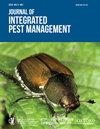Biology and Management of Peanut Burrower Bug (Hemiptera: Cydnidae) in Southeast U.S. Peanut
IF 2.7
3区 农林科学
Q1 ENTOMOLOGY
引用次数: 1
Abstract
Peanut burrower bug, Pangaeus bilineatus (Say), is a piercing-sucking pest of peanut, Arachis hypogaea (L.), that is native to Central and North America. The insect spends most of its life below the soil surface and is not easily detected in the field. Although injury to peanut is sporadic in the Southern USA, the bug has become a serious economic pest for farmers in the region in recent years. During and after peanut seed formation, adult and immature bugs feed directly on seeds through the hull, reducing the quality and value of the crop. The value of peanut is reduced by approximately $209/MT when feeding injury is present on ≥3.5% of kernels by weight. Deep tillage prior to planting and application of granular chlorpyrifos during the growing season are the only tactics currently available for managing P. bilineatus in peanut in the United States. Relatively little research attention has been focused on P. bilineatus, and improved knowledge of the insect’s biology and ecology is needed to develop an integrated pest management (IPM) strategy that significantly reduces financial losses caused by this insect. The purpose of this article is to provide a review of the taxonomic history, biology, pest status, and management of P. bilineatus primarily as it relates to peanut production systems in the Southeast USA.美国花生东南地区花生洞虫的生物学及防治
花生洞虫,Pangaeus bilineatus (Say),是一种刺噬花生的害虫,花生是原产于中美洲和北美洲的花生。这种昆虫一生大部分时间都生活在土壤表面以下,在田间不易被发现。虽然对花生的伤害在美国南部是零星的,但这种虫子近年来已成为该地区农民的严重经济害虫。在花生种子形成期间和之后,成虫和未成熟虫通过外壳直接取食种子,降低了作物的质量和价值。当≥3.5%的花生籽粒(按重量计)受到摄食损伤时,花生价值减少约209美元/吨。在美国,种植前深耕和生长季节施用颗粒毒死蜱是目前唯一可用于管理花生中双头虫的策略。相对较少的研究关注集中在双头瓢虫上,需要提高对昆虫生物学和生态学的认识,以制定综合虫害管理(IPM)策略,显著减少双头瓢虫造成的经济损失。本文的目的是提供的分类历史,生物学,害虫现状和管理的综述,主要是因为它涉及到花生生产系统在美国东南部。
本文章由计算机程序翻译,如有差异,请以英文原文为准。
求助全文
约1分钟内获得全文
求助全文
来源期刊

Journal of Integrated Pest Management
Agricultural and Biological Sciences-Insect Science
CiteScore
5.80
自引率
3.60%
发文量
24
审稿时长
25 weeks
期刊介绍:
Journal of Integrated Pest Management is an open access, peer-reviewed, extension journal covering the field of integrated pest management. The Editors-in-Chief are Dr. Marlin E. Rice (formerly with Iowa State University) and Dr. Kevin L. Steffey (formerly with the University of Illinois). The journal is multi-disciplinary in scope, publishing articles in all pest management disciplines, including entomology, nematology, plant pathology, weed science, and other subject areas.
 求助内容:
求助内容: 应助结果提醒方式:
应助结果提醒方式:


